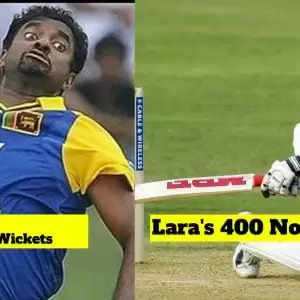The first Test match was played in 1877 between England and Australia while the first limited-overs game took place in 1971, which was indeed a time-filler after a Test match had been abandoned because of heavy rain on the opening days.
That experiment of a limited-overs fixture became popular and began to be known as one-day internationals (ODIs) and the first Cricket World Cup was staged in 1975.
Then, at the start of the 21st century, came the shortest format, a 20-over per innings dash, later made famous by the 2007 T20 World Cup.
Many great cricketers have endorsed this great game for more than a century, breaking and creating some historic records.
Here we look at 5 unbreakable records which are nearly impossible to be broken in the future:
1. 100 International Centuries of Sachin Tendulkar

Sachin Tendulkar, arguably the most talented batsman to have ever taken the field, remains at the pinnacle of batting in international cricket. Also revered as the God of Cricket, Tendulkar has breached the century mark a total of 100 times in his glorious career – 51 in Tests and 49 in ODIs.
Behind him – and by miles – is former Australian skipper Ricky Ponting with 71 centuries. India’s talismanic batsman Virat Kohli has often been touted to break Tendulkar’s 100 centuries record. However, Kohli has been stuck on 70 international tons for the last two years, and it seems that the 33-year-old won’t surpass Tendulkar as was believed earlier.
With 34357 international runs – 15,921 runs in ODIs and 18,426 runs in Tests – Tendulkar continues to remain the all-time leading run-scorer at the highest level; Kohli has amassed 23358 runs so far. This records tops our list of unbreakable records in cricket.
2. Sir Don Bradman’s averages of 99.94 in Test cricket
Regarded as the greatest batsman ever, Sir Donald Bradman played in 52 Test matches in which he scored 6996 runs at an astounding average of 99.94 – the most for any batsman to have played at least 10 Tests. Nobody in the history of the game comes close to Bradman’s astronomical average and nobody is likely to.
Also, 12 of his 19 Test centuries are double hundreds – the most for a batsman. This record is the difficult record to conquer in our list of unbreakable records.
3. Brian Lara’s highest Test innings score of 400*

Brian Lara’s marathon innings that lasted 778 minutes, 582 balls, that yielded him a record 400* in 2004 against England remains the highest individual Test innings total by a batter. And despite the fast pace of scoring over the past decade, no batter has come close to this landmark over the last 10 years.
Lara had broken Matthew Hayden’s record of 380 that the Aussie had set in 2003. However, Lara’s knock has at times been criticised for being selfish as the game ended in a draw with England clinging on by 5 wickets in their second innings.
David Warner threatened to breach this figure when he was on song against Pakistan in 2019 at Adelaide before captain Tim Paine declared asking Warner to come back on 335*. With the World Test Championship points at stake and knowing the pitch and weather conditions, Paine had taken that decision.
4. Muttiah Muralitharan’s 1300 international wickets
Legendary Sri Lankan spinner Muttiah Muralitharan retired with a total of 1347 – 800 in Tests, 534 in ODI, and 13 in T20I – international wickets. Shane Warne is next with 1001 scalps.
This record is nigh-impossible to break considering that bowlers are regularly rested in these times and pitches in limited-overs cricket are usually batting-friendly.
5. Rohit Sharma’s highest ODI score of 264 runs
India opener Rohit Sharma registered the highest score by any batsman in ODI cricket: 264 runs from 173 balls against Sri Lanka in 2014. Sharma is the only batsman with more than one – 3 – double centuries in ODI cricket.
In that historic 264-run knock, Sharma had batted at almost run-a-ball for the first half of his innings – he got his hundred in the 32nd over – before turning on the heat in the last 15 overs.
But, to remember is that the powerplay rules at the time allowed only a maximum of 4 fielders outside the circle even in the last 10 overs of the innings. That, though, has changed and now 5 fielders are allowed in the last 10 overs, making it almost impossible for a batter to go past Sharma’s mind-boggling record.

